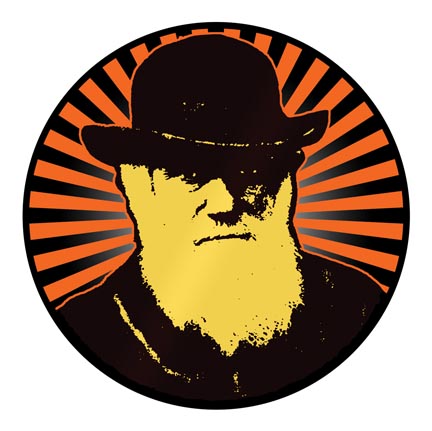The Axis of Evo
“The notion that young kids cannot understand evolution is a myth perpetuated by those who don’t want kids to understand evolution,” says biologist Colin Purrington.

In anticipation of the 200th anniversary of Charles Darwin’s birth in February 2009, Purrington ordered 1,000 temporary tattoos of his own design, derived from an 1881 photo of Darwin. They are available at his site.

This road sign (above) is one of the most often downloaded images on Purrington’s site: “It was even used by one high school teacher on her class blog, which warms my heart," he says. It’s based on a sketch in one of Charles Darwin’s notebooks, dated 1837 (as seen below).

Is your dachshund named Darwin? If so, he (or she) can join Purrington’s Pets Named Darwin Club, which has more than 80 members represented by their on-line photos. “If you have friends who are expecting pets,” he states, “please float Darwin as a great name, then send them here.” This highly evolved dog belongs to Erica Wines.
In addition to course descriptions and information about his research interests, Associate Professor of Biology Colin Purrington’s Web page has a “bonus feature.” Click on an image of Charles Darwin and you arrive at his “Evolution Outreach Projects—Part of the Axis of Evo.”
Purrington’s bonus site provides resources for teachers, parents, and others who believe that “species continue to evolve today through nonmagical processes such as natural selection.” It reflects his passion for science education—and his outrage that Americans’ “strong faith in alternative, supernatural explanations is maintained by indoctrination of young children by parents and facilitated by public school curricula that purposefully delay evolutionary biology instruction until high school.”
Purrington’s sly sense of humor permeates many offerings on the site, which includes body armor for science teachers (“great for making presentations to backward school boards, but light enough for classroom use”); downloadable Charles Darwin stickers and temporary tattoos (“Darwin has a posse”); and “mildly educational” textbook disclaimer stickers meant to be surreptitiously applied both to science books and creationist tracts. Sticker messages include: “This textbook states that the Earth is over 4 billion years old. Because this fact conflicts rather directly with a hugely popular fictional account, both sides of the argument should be taught to impressionable children”; and “This book was anonymously donated to your school library to discreetly promote magical, religious alternatives to the theory of evolution. Please re-shelve it in the fiction section.”
But alongside his lighthearted—and sometimes venomous—jabs at creationists, Purrington offers some serious help: an illustrated article on Galápagos tortoise evolution, assorted graphics for science presentations, suggestions for improving evolution education at zoos and museums, and links to groups like the Pennsylvania Citizens for Science and the National Center for Science Education.
We asked Purrington to explain some of the reasons behind this “evo” outreach:
“Because I teach evolution, I have a professional obsession with when and how people come to hate the theory. Many people suspect that there might be something immoral about accepting evolution—and that there is certainly something wrong with people who spend all day teaching the theory to children. Once, after a presentation I made about teaching evolution to young kids, another speaker (a particle physicist) pointed at me and said that asking teachers to inform elementary school kids about Darwin was a ‘crime against humanity.’ In my view, the true crime is withholding evolution instruction until high school or college.
“Kids—especially very young kids—are naturally interested in the origin of life, the origin of humans, and what it means to be alive. Teaching evolution to older kids just doesn’t work; you have to start with toddlers.
“So, several years ago, I decided that simply teaching evolution to a few thousand Swarthmore students over the life of my career wasn’t going to really change public attitudes. I felt I had to do something to speed up the acceptance of evolution. This work is not going to stop global warming or make gas cheaper, but I feel strongly that science education is hobbled in part because other aspects of science are so often associated with evolution. If people accept and enjoy the science of evolution, we might have a better overall science education policy in the United States—and that would be a good thing.
“I optimistically started a collection of pro-evolution Web pages that I collectively call my Evolution Outreach Projects, with the hope that some of them might be virally transmitted often enough to slowly influence those on the Internet who might be swayed. I often describe these projects as part of the “Axis of Evo” to make it clear that this type of endeavor is pure evil to some. But for others, I hope it is a welcome relief from the anti-science, ignorance-is-virtue culture that has become so popular in our country.
“The success of Web sites is often measured in hits or sales, but for me it’s the feedback I get from people who’ve stumbled onto the sites and consumed the content as I hoped they would. My ultimate goal is that my projects plant the idea in parents that it is possible to talk about evolution to their kids—and that the kids will love it. One person who wrote to me made it all worthwhile: ‘My wife is pregnant; I have bookmarked your site for when the wee one approaches me with questions about from whence we came. I know that it’s a cliché, but keep up the good work.’”
Find Colin Purrington’s Evolution Outreach Projects on the Web at www.swarthmore.edu/NatSci/cpurrin1/evolk12/evoops.htm.
 Email This Page
Email This Page
